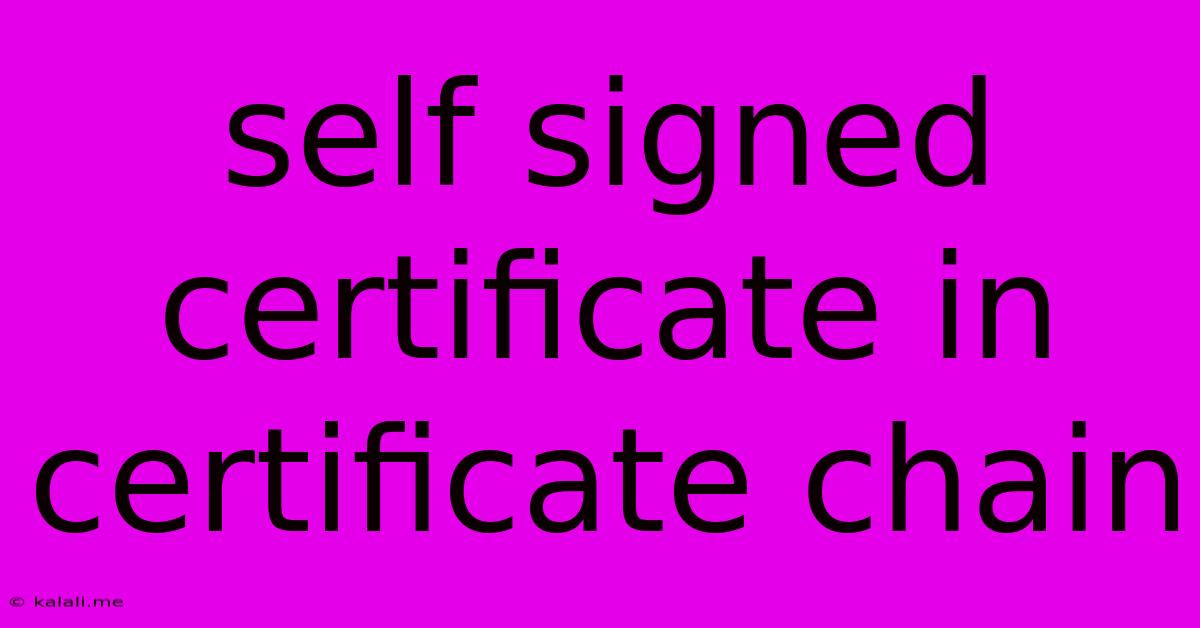Self Signed Certificate In Certificate Chain
Kalali
May 19, 2025 · 3 min read

Table of Contents
Understanding Self-Signed Certificates and Their Place in the Certificate Chain
A self-signed certificate is a digital certificate that is signed by the same entity that issued it. Unlike certificates issued by Certificate Authorities (CAs) like Let's Encrypt or DigiCert, which are widely trusted, self-signed certificates are not inherently trusted by web browsers or other applications. This lack of trust stems from their absence from the established certificate chain of trust. This article will delve into what this means, the implications of using them, and when they might be appropriate.
What is a Certificate Chain of Trust?
Think of a certificate chain as a line of endorsements. A website's SSL/TLS certificate is typically issued by a trusted Certificate Authority (CA). This CA, in turn, has its own certificate signed by a root CA, and so on up the chain. This chain ensures that the website's certificate is authentic and hasn't been tampered with. Each certificate in the chain verifies the authenticity of the next, ultimately connecting back to a root certificate that is pre-installed and trusted by your operating system or browser.
How Self-Signed Certificates Differ
A self-signed certificate breaks this chain. There's no intermediary CA to vouch for its authenticity. The certificate itself asserts its own validity. This means that when your browser encounters a website using a self-signed certificate, it will typically display a warning, indicating that the certificate's identity cannot be verified. This warning is crucial because it alerts users to a potential security risk. An attacker could potentially create a self-signed certificate mimicking a legitimate website, potentially leading to phishing or man-in-the-middle attacks.
Why Use Self-Signed Certificates?
Despite the inherent security concerns, self-signed certificates have legitimate uses in specific contexts:
-
Internal Networks: For applications or websites accessible only within a private network (like a company intranet), a self-signed certificate offers a simple way to enable HTTPS encryption without the need for a paid CA certificate. The trust is already established within the controlled environment.
-
Development and Testing: During development and testing phases, developers often use self-signed certificates to secure their applications without the overhead of obtaining and managing CA-signed certificates.
-
Limited Budget Scenarios: In situations where purchasing a CA-signed certificate is not feasible due to budget constraints, a self-signed certificate provides a basic level of security. However, the security implications should be carefully considered.
Security Implications of Self-Signed Certificates
It's crucial to understand the security limitations:
-
Lack of Trust: The most significant risk is the lack of inherent trust. Users will see a security warning, potentially deterring them from accessing the website or application.
-
Vulnerability to Attacks: Self-signed certificates are significantly more vulnerable to man-in-the-middle attacks and phishing attempts.
-
Limited Applicability: Self-signed certificates are unsuitable for publicly accessible websites or applications where trust and security are paramount.
Alternatives to Self-Signed Certificates
For production environments and public-facing applications, always prioritize using certificates issued by trusted Certificate Authorities. The relatively low cost and enhanced security provided by CA-signed certificates far outweigh the risks associated with self-signed certificates. Free options like Let's Encrypt are readily available for securing websites.
Conclusion
Self-signed certificates have a place in specific, controlled environments like internal networks or during development. However, their lack of trust and increased vulnerability to attacks make them unsuitable for publicly accessible applications. The risks associated with using self-signed certificates should always be carefully weighed against the potential benefits. For public-facing applications, obtaining a certificate from a reputable Certificate Authority remains the best practice for ensuring security and user trust.
Latest Posts
Latest Posts
-
7am To 11am Is How Many Hours
Jul 12, 2025
-
If Your 35 What Year Was You Born
Jul 12, 2025
-
How Many Cups Is 1 Pound Of Cheese
Jul 12, 2025
-
30 X 30 Is How Many Square Feet
Jul 12, 2025
-
How Much Does A Half Oz Weigh
Jul 12, 2025
Related Post
Thank you for visiting our website which covers about Self Signed Certificate In Certificate Chain . We hope the information provided has been useful to you. Feel free to contact us if you have any questions or need further assistance. See you next time and don't miss to bookmark.